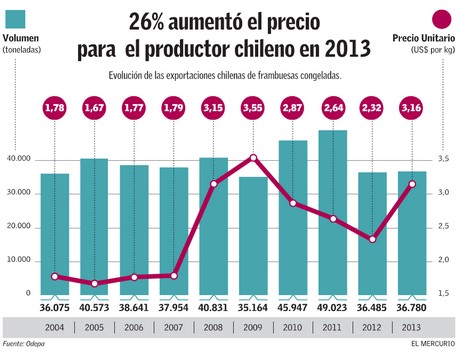This is no accident. According to an analysis by Odepa, part of the Ministry of Agriculture, the reduction caused by the weather in the production volumes of Serbia and Poland, the major exporting countries in the world, is the main reason why the Chilean berry is doing so good.
Below chart in Spanish

Odepa's report states that the weather problems in Serbia, Poland and the United States both in 2012 and 2013 had negative effects on crop yields. The clearest example of this is Poland, which, according to figures from the International Raspberry Organization, only obtained 105,000 tons of the 127,000 tons that the government had predicted.
"In the last couple of years, the international price of frozen raspberry has been through the roof as a result of the poor harvests in other countries," says Antonio Dominguez, director of Chilealimentos and president of Nevada Export. Since 90% of the raspberry Chile exports are frozen, the country has benefited from this external circumstances.
If this northern hemisphere's season continues to develop normally, the two leading producers should rebound in volume.
"This year, Serbia's spring will kick in with a lot of warmth. This is negative for most fruits, as it exposes the flowers to frost but, since the raspberries bloom later on, and if it rains in May and June, the country will increase its production. According to our current information, something similar is expected to happen in Poland," says Felipe Rosas, from RConsulting.
According to the experts, even though it's difficult to predict the weather in these countries, there is a high probability that they will increase their production in 2014 and that prices will decrease globally. "We are four months away from the beginning of the northern hemisphere's harvest, but it's still very difficult to predict how the weather will be in the long run, and that is the most influential factor of the harvest," he said.
Challenges for Chilean producers
According to Odepa's report and to Felipe Rosas, one of the goals for domestic producers is to improve the varieties they produce.
"Unfortunately, the current prices don't encourage farmers to make changes and improve yields, which are very serious issues in Chile," noted Rosas.
For example, according to Odepa, the production potential of the heritage variety, which is grown in almost 80% of Chilean orchards, has decreased significantly. As a result, there are different breeding research programs being carried out within the country, such as a project from the Catholic University, aimed at finding varieties that can adapt to the local conditions. Raspberry producers must also find varieties that are more resistant to the mechanization of orchards, a future trend in agriculture.
The frozen raspberries industry should continue developing as it has in recent years and, according to Odepa, one of its main challenges is to make the relationship between farmers and industry more formal.







